Financial Strategies, Cost Analysis, and Pricing for Thomas Cook
VerifiedAdded on 2020/06/04
|9
|2289
|27
Report
AI Summary
This report provides a comprehensive financial analysis of Thomas Cook, a leading travel and tourism company. It begins with a background of the company and then delves into the discussion and recommendation of relevant sources of finance for expansion, contrasting the implications of long-term debt and equity capital. The report then explores cost behavior, differentiating between fixed, variable, and semi-variable costs, and emphasizes the importance of Cost-Volume-Profit (CVP) analysis as a critical decision-making tool for assessing profitability and break-even points. Finally, the report discusses and recommends appropriate pricing strategies, including cost-plus, competition-based, demand-based, and seasonal pricing, providing insights into how Thomas Cook can optimize its financial strategies in a competitive market. The report concludes with recommendations for a balanced financial approach and highlights the significance of CVP analysis and competitive-based pricing for effective decision-making. This report is available on Desklib, a platform offering AI-based study tools and past assignments for students.
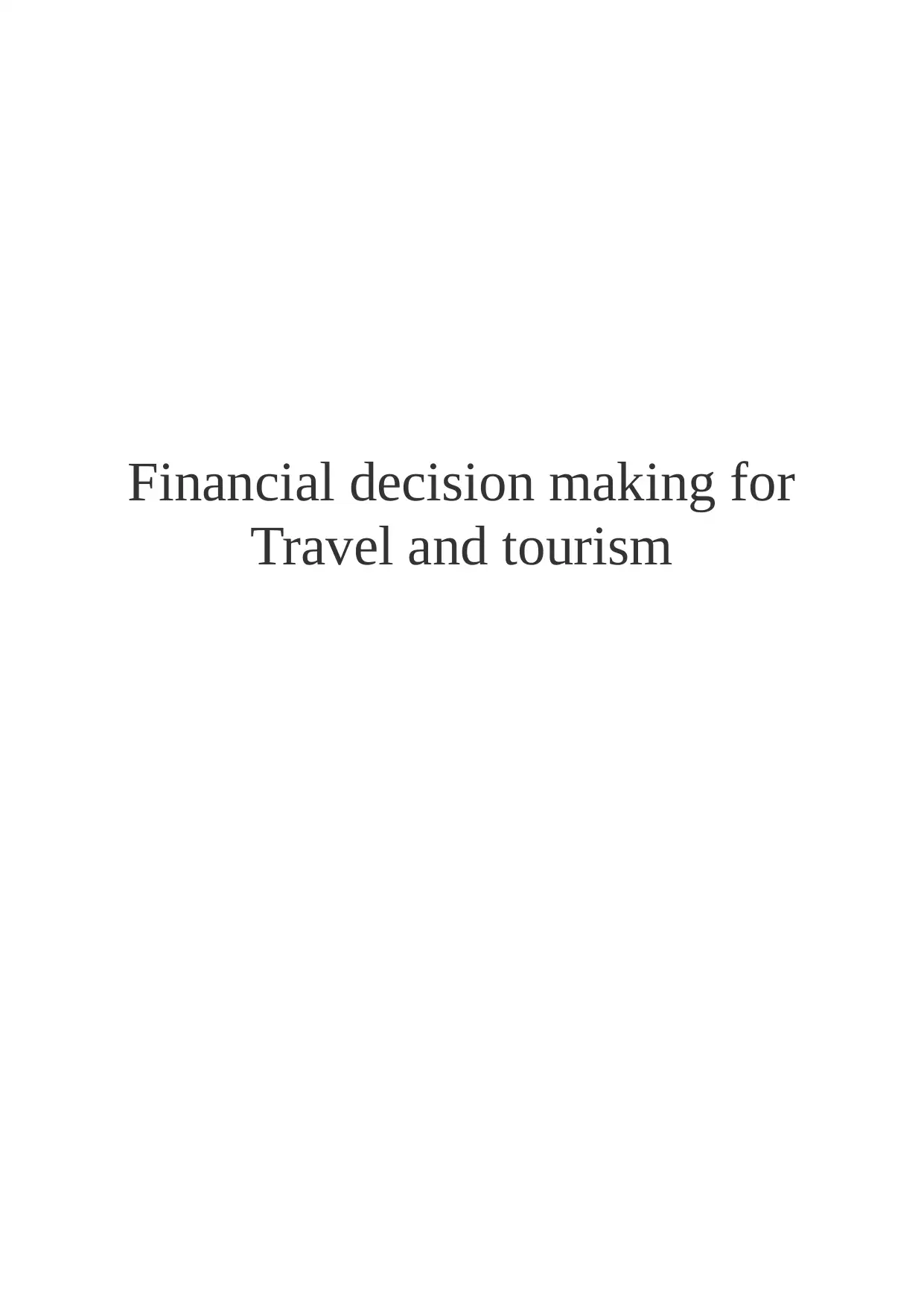
Financial decision making for
Travel and tourism
Travel and tourism
Paraphrase This Document
Need a fresh take? Get an instant paraphrase of this document with our AI Paraphraser
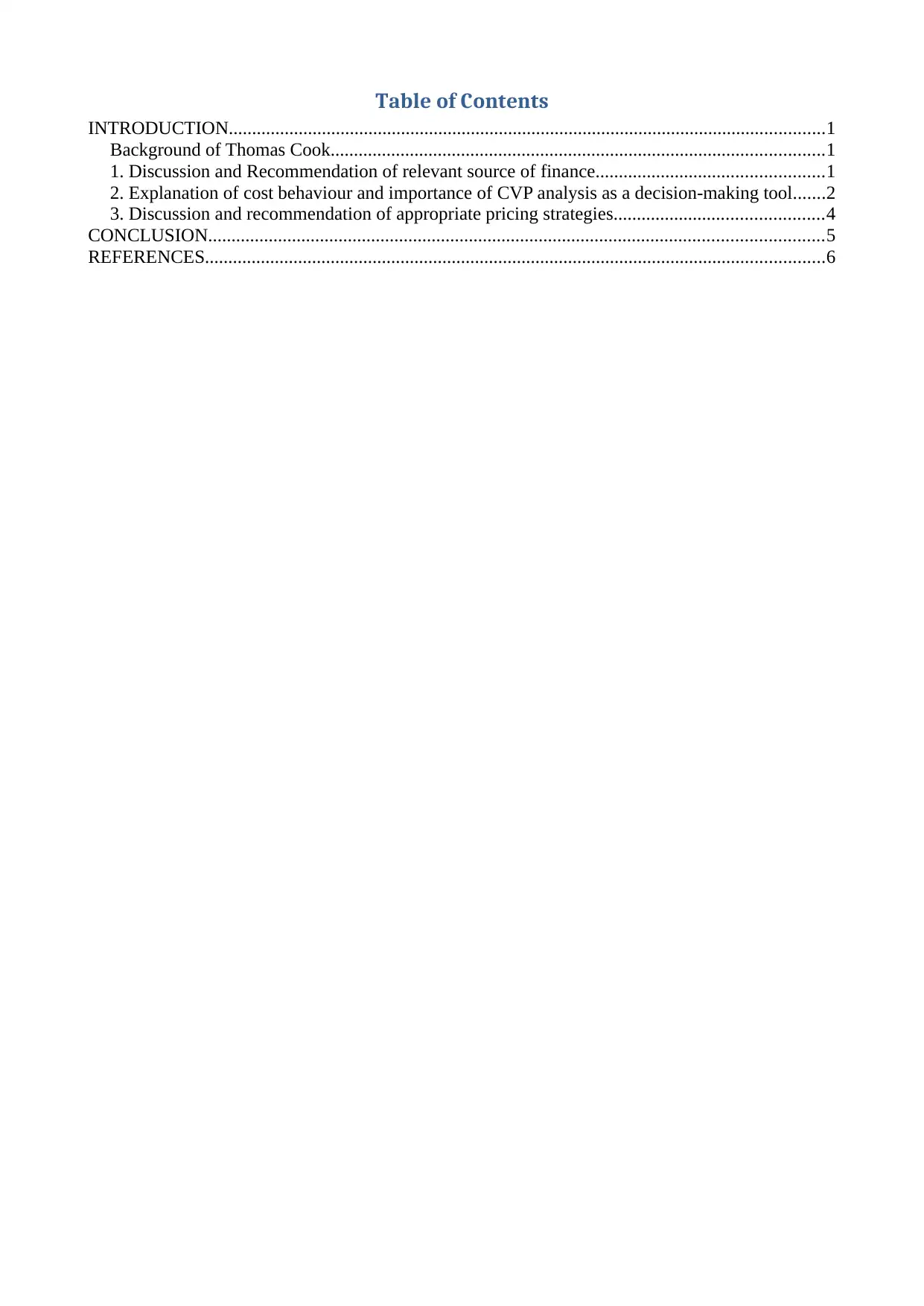
Table of Contents
INTRODUCTION................................................................................................................................1
Background of Thomas Cook..........................................................................................................1
1. Discussion and Recommendation of relevant source of finance.................................................1
2. Explanation of cost behaviour and importance of CVP analysis as a decision-making tool.......2
3. Discussion and recommendation of appropriate pricing strategies.............................................4
CONCLUSION....................................................................................................................................5
REFERENCES.....................................................................................................................................6
INTRODUCTION................................................................................................................................1
Background of Thomas Cook..........................................................................................................1
1. Discussion and Recommendation of relevant source of finance.................................................1
2. Explanation of cost behaviour and importance of CVP analysis as a decision-making tool.......2
3. Discussion and recommendation of appropriate pricing strategies.............................................4
CONCLUSION....................................................................................................................................5
REFERENCES.....................................................................................................................................6
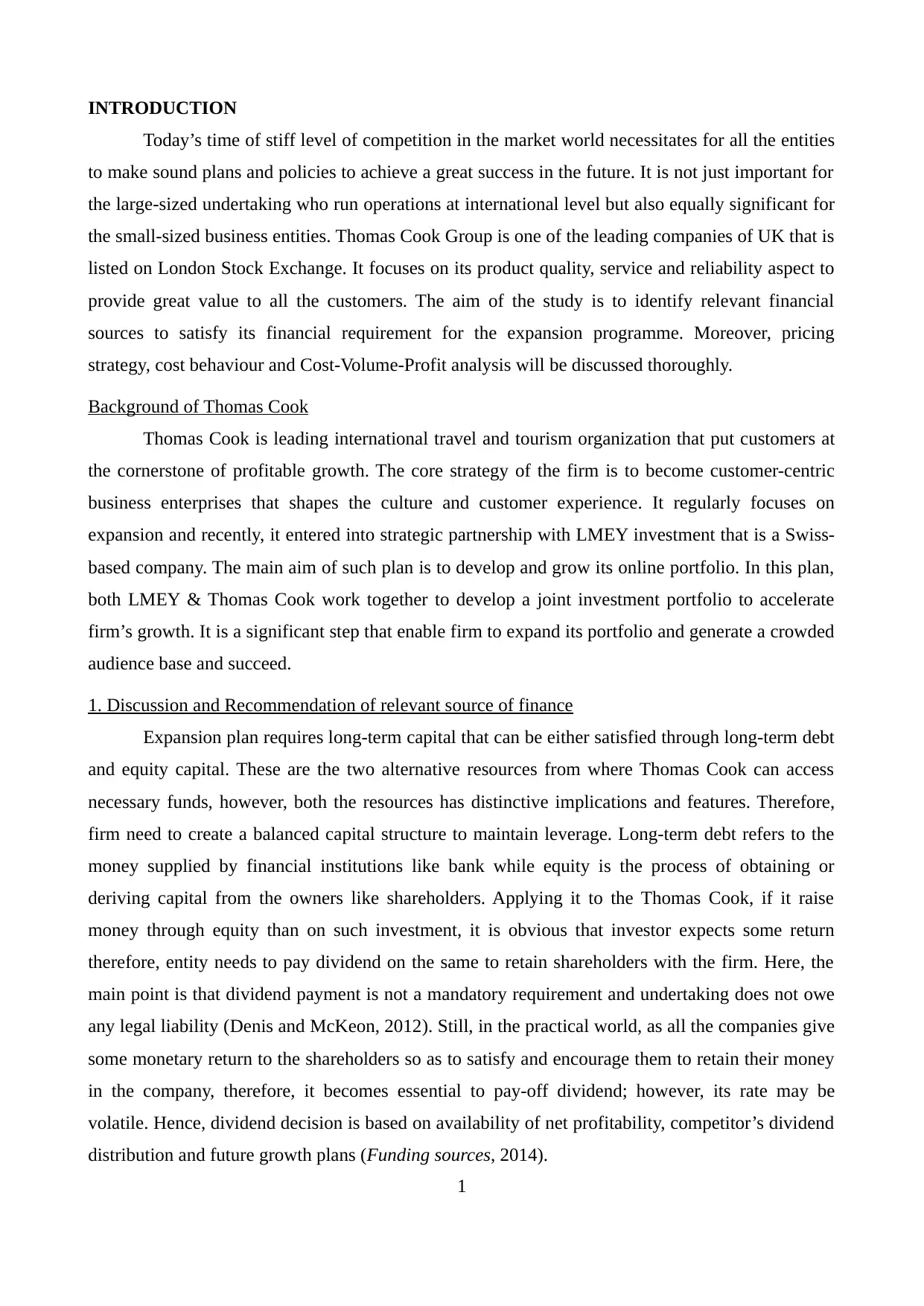
INTRODUCTION
Today’s time of stiff level of competition in the market world necessitates for all the entities
to make sound plans and policies to achieve a great success in the future. It is not just important for
the large-sized undertaking who run operations at international level but also equally significant for
the small-sized business entities. Thomas Cook Group is one of the leading companies of UK that is
listed on London Stock Exchange. It focuses on its product quality, service and reliability aspect to
provide great value to all the customers. The aim of the study is to identify relevant financial
sources to satisfy its financial requirement for the expansion programme. Moreover, pricing
strategy, cost behaviour and Cost-Volume-Profit analysis will be discussed thoroughly.
Background of Thomas Cook
Thomas Cook is leading international travel and tourism organization that put customers at
the cornerstone of profitable growth. The core strategy of the firm is to become customer-centric
business enterprises that shapes the culture and customer experience. It regularly focuses on
expansion and recently, it entered into strategic partnership with LMEY investment that is a Swiss-
based company. The main aim of such plan is to develop and grow its online portfolio. In this plan,
both LMEY & Thomas Cook work together to develop a joint investment portfolio to accelerate
firm’s growth. It is a significant step that enable firm to expand its portfolio and generate a crowded
audience base and succeed.
1. Discussion and Recommendation of relevant source of finance
Expansion plan requires long-term capital that can be either satisfied through long-term debt
and equity capital. These are the two alternative resources from where Thomas Cook can access
necessary funds, however, both the resources has distinctive implications and features. Therefore,
firm need to create a balanced capital structure to maintain leverage. Long-term debt refers to the
money supplied by financial institutions like bank while equity is the process of obtaining or
deriving capital from the owners like shareholders. Applying it to the Thomas Cook, if it raise
money through equity than on such investment, it is obvious that investor expects some return
therefore, entity needs to pay dividend on the same to retain shareholders with the firm. Here, the
main point is that dividend payment is not a mandatory requirement and undertaking does not owe
any legal liability (Denis and McKeon, 2012). Still, in the practical world, as all the companies give
some monetary return to the shareholders so as to satisfy and encourage them to retain their money
in the company, therefore, it becomes essential to pay-off dividend; however, its rate may be
volatile. Hence, dividend decision is based on availability of net profitability, competitor’s dividend
distribution and future growth plans (Funding sources, 2014).
1
Today’s time of stiff level of competition in the market world necessitates for all the entities
to make sound plans and policies to achieve a great success in the future. It is not just important for
the large-sized undertaking who run operations at international level but also equally significant for
the small-sized business entities. Thomas Cook Group is one of the leading companies of UK that is
listed on London Stock Exchange. It focuses on its product quality, service and reliability aspect to
provide great value to all the customers. The aim of the study is to identify relevant financial
sources to satisfy its financial requirement for the expansion programme. Moreover, pricing
strategy, cost behaviour and Cost-Volume-Profit analysis will be discussed thoroughly.
Background of Thomas Cook
Thomas Cook is leading international travel and tourism organization that put customers at
the cornerstone of profitable growth. The core strategy of the firm is to become customer-centric
business enterprises that shapes the culture and customer experience. It regularly focuses on
expansion and recently, it entered into strategic partnership with LMEY investment that is a Swiss-
based company. The main aim of such plan is to develop and grow its online portfolio. In this plan,
both LMEY & Thomas Cook work together to develop a joint investment portfolio to accelerate
firm’s growth. It is a significant step that enable firm to expand its portfolio and generate a crowded
audience base and succeed.
1. Discussion and Recommendation of relevant source of finance
Expansion plan requires long-term capital that can be either satisfied through long-term debt
and equity capital. These are the two alternative resources from where Thomas Cook can access
necessary funds, however, both the resources has distinctive implications and features. Therefore,
firm need to create a balanced capital structure to maintain leverage. Long-term debt refers to the
money supplied by financial institutions like bank while equity is the process of obtaining or
deriving capital from the owners like shareholders. Applying it to the Thomas Cook, if it raise
money through equity than on such investment, it is obvious that investor expects some return
therefore, entity needs to pay dividend on the same to retain shareholders with the firm. Here, the
main point is that dividend payment is not a mandatory requirement and undertaking does not owe
any legal liability (Denis and McKeon, 2012). Still, in the practical world, as all the companies give
some monetary return to the shareholders so as to satisfy and encourage them to retain their money
in the company, therefore, it becomes essential to pay-off dividend; however, its rate may be
volatile. Hence, dividend decision is based on availability of net profitability, competitor’s dividend
distribution and future growth plans (Funding sources, 2014).
1
⊘ This is a preview!⊘
Do you want full access?
Subscribe today to unlock all pages.

Trusted by 1+ million students worldwide
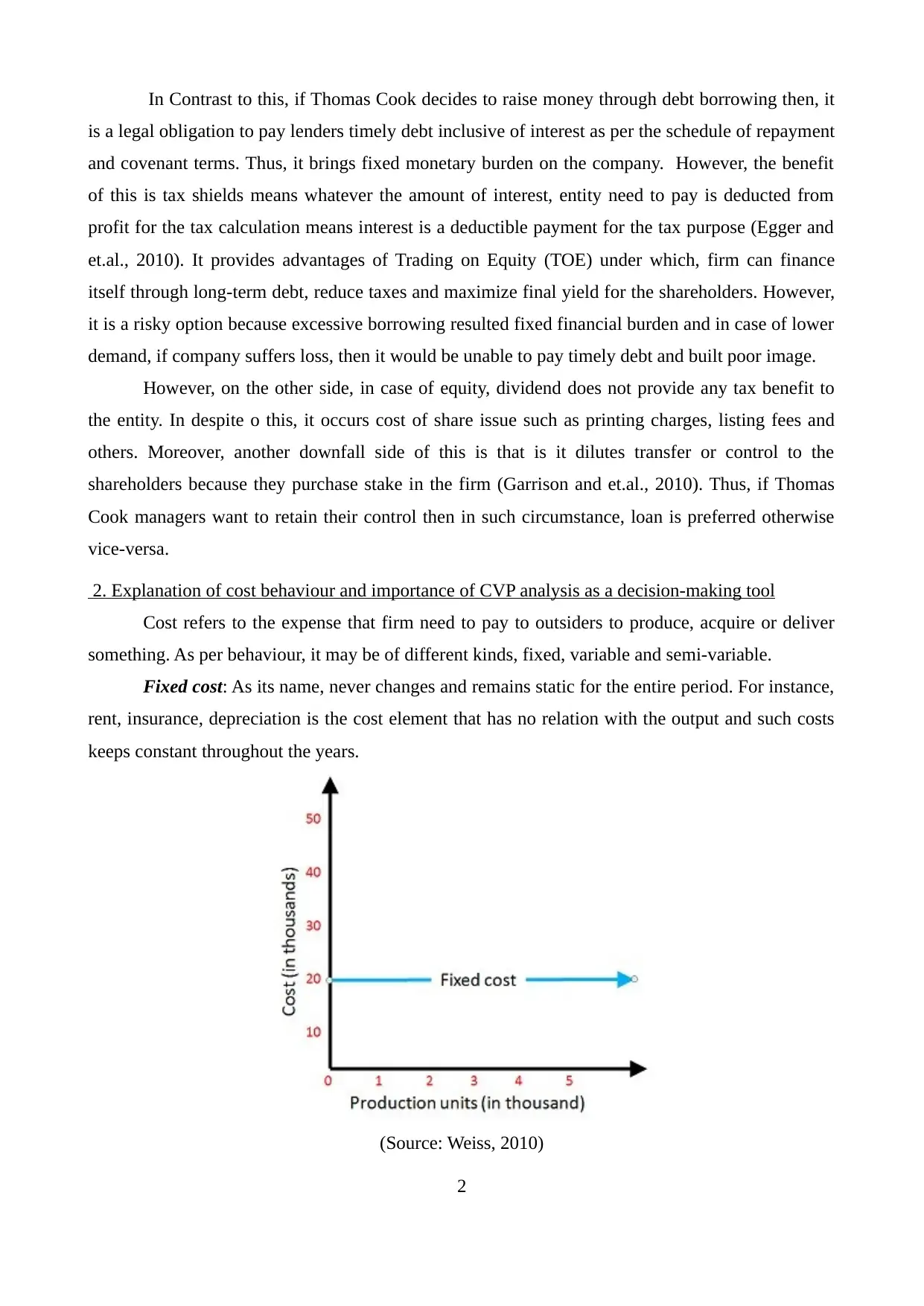
In Contrast to this, if Thomas Cook decides to raise money through debt borrowing then, it
is a legal obligation to pay lenders timely debt inclusive of interest as per the schedule of repayment
and covenant terms. Thus, it brings fixed monetary burden on the company. However, the benefit
of this is tax shields means whatever the amount of interest, entity need to pay is deducted from
profit for the tax calculation means interest is a deductible payment for the tax purpose (Egger and
et.al., 2010). It provides advantages of Trading on Equity (TOE) under which, firm can finance
itself through long-term debt, reduce taxes and maximize final yield for the shareholders. However,
it is a risky option because excessive borrowing resulted fixed financial burden and in case of lower
demand, if company suffers loss, then it would be unable to pay timely debt and built poor image.
However, on the other side, in case of equity, dividend does not provide any tax benefit to
the entity. In despite o this, it occurs cost of share issue such as printing charges, listing fees and
others. Moreover, another downfall side of this is that is it dilutes transfer or control to the
shareholders because they purchase stake in the firm (Garrison and et.al., 2010). Thus, if Thomas
Cook managers want to retain their control then in such circumstance, loan is preferred otherwise
vice-versa.
2. Explanation of cost behaviour and importance of CVP analysis as a decision-making tool
Cost refers to the expense that firm need to pay to outsiders to produce, acquire or deliver
something. As per behaviour, it may be of different kinds, fixed, variable and semi-variable.
Fixed cost: As its name, never changes and remains static for the entire period. For instance,
rent, insurance, depreciation is the cost element that has no relation with the output and such costs
keeps constant throughout the years.
(Source: Weiss, 2010)
2
is a legal obligation to pay lenders timely debt inclusive of interest as per the schedule of repayment
and covenant terms. Thus, it brings fixed monetary burden on the company. However, the benefit
of this is tax shields means whatever the amount of interest, entity need to pay is deducted from
profit for the tax calculation means interest is a deductible payment for the tax purpose (Egger and
et.al., 2010). It provides advantages of Trading on Equity (TOE) under which, firm can finance
itself through long-term debt, reduce taxes and maximize final yield for the shareholders. However,
it is a risky option because excessive borrowing resulted fixed financial burden and in case of lower
demand, if company suffers loss, then it would be unable to pay timely debt and built poor image.
However, on the other side, in case of equity, dividend does not provide any tax benefit to
the entity. In despite o this, it occurs cost of share issue such as printing charges, listing fees and
others. Moreover, another downfall side of this is that is it dilutes transfer or control to the
shareholders because they purchase stake in the firm (Garrison and et.al., 2010). Thus, if Thomas
Cook managers want to retain their control then in such circumstance, loan is preferred otherwise
vice-versa.
2. Explanation of cost behaviour and importance of CVP analysis as a decision-making tool
Cost refers to the expense that firm need to pay to outsiders to produce, acquire or deliver
something. As per behaviour, it may be of different kinds, fixed, variable and semi-variable.
Fixed cost: As its name, never changes and remains static for the entire period. For instance,
rent, insurance, depreciation is the cost element that has no relation with the output and such costs
keeps constant throughout the years.
(Source: Weiss, 2010)
2
Paraphrase This Document
Need a fresh take? Get an instant paraphrase of this document with our AI Paraphraser
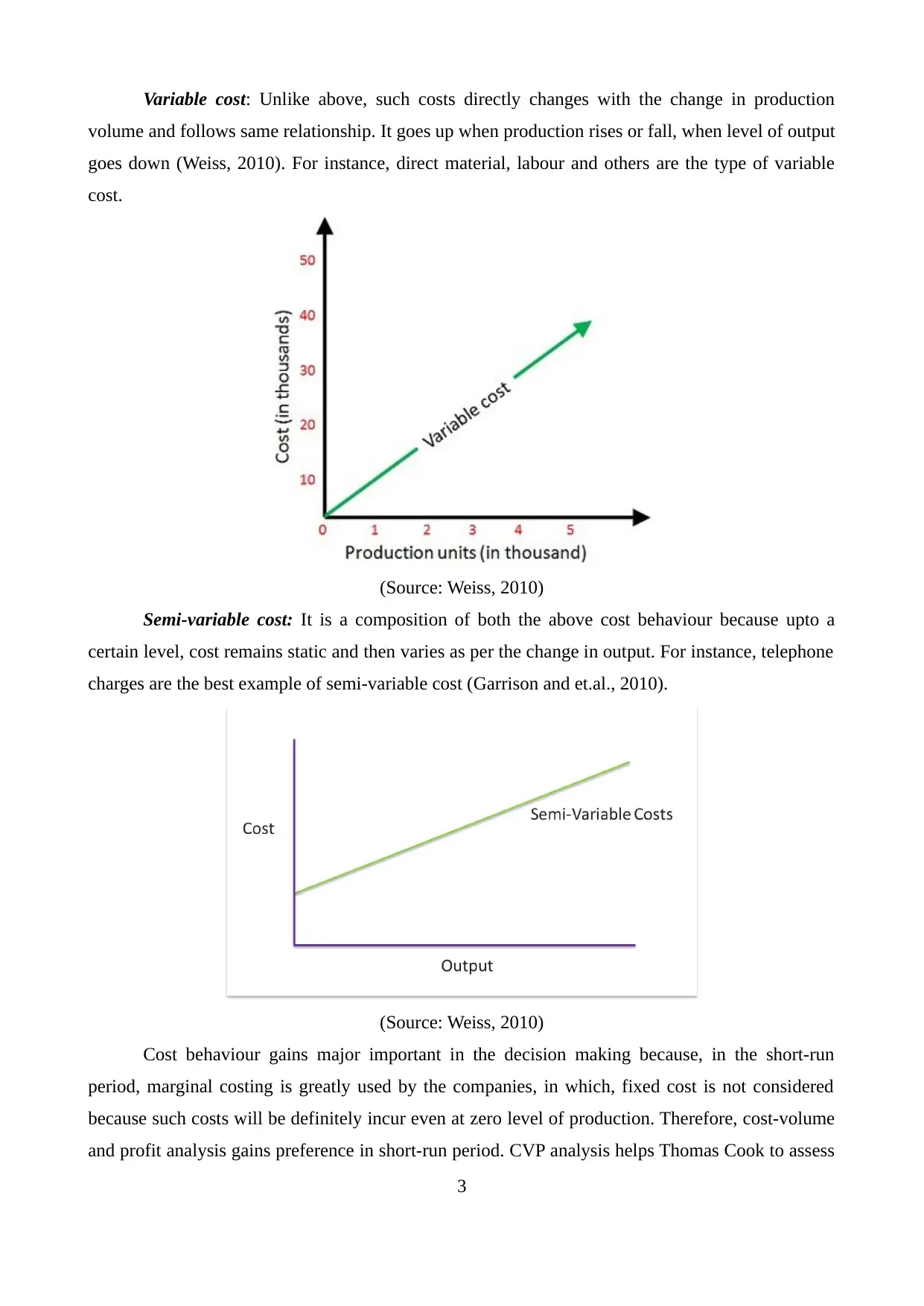
Variable cost: Unlike above, such costs directly changes with the change in production
volume and follows same relationship. It goes up when production rises or fall, when level of output
goes down (Weiss, 2010). For instance, direct material, labour and others are the type of variable
cost.
(Source: Weiss, 2010)
Semi-variable cost: It is a composition of both the above cost behaviour because upto a
certain level, cost remains static and then varies as per the change in output. For instance, telephone
charges are the best example of semi-variable cost (Garrison and et.al., 2010).
(Source: Weiss, 2010)
Cost behaviour gains major important in the decision making because, in the short-run
period, marginal costing is greatly used by the companies, in which, fixed cost is not considered
because such costs will be definitely incur even at zero level of production. Therefore, cost-volume
and profit analysis gains preference in short-run period. CVP analysis helps Thomas Cook to assess
3
volume and follows same relationship. It goes up when production rises or fall, when level of output
goes down (Weiss, 2010). For instance, direct material, labour and others are the type of variable
cost.
(Source: Weiss, 2010)
Semi-variable cost: It is a composition of both the above cost behaviour because upto a
certain level, cost remains static and then varies as per the change in output. For instance, telephone
charges are the best example of semi-variable cost (Garrison and et.al., 2010).
(Source: Weiss, 2010)
Cost behaviour gains major important in the decision making because, in the short-run
period, marginal costing is greatly used by the companies, in which, fixed cost is not considered
because such costs will be definitely incur even at zero level of production. Therefore, cost-volume
and profit analysis gains preference in short-run period. CVP analysis helps Thomas Cook to assess
3
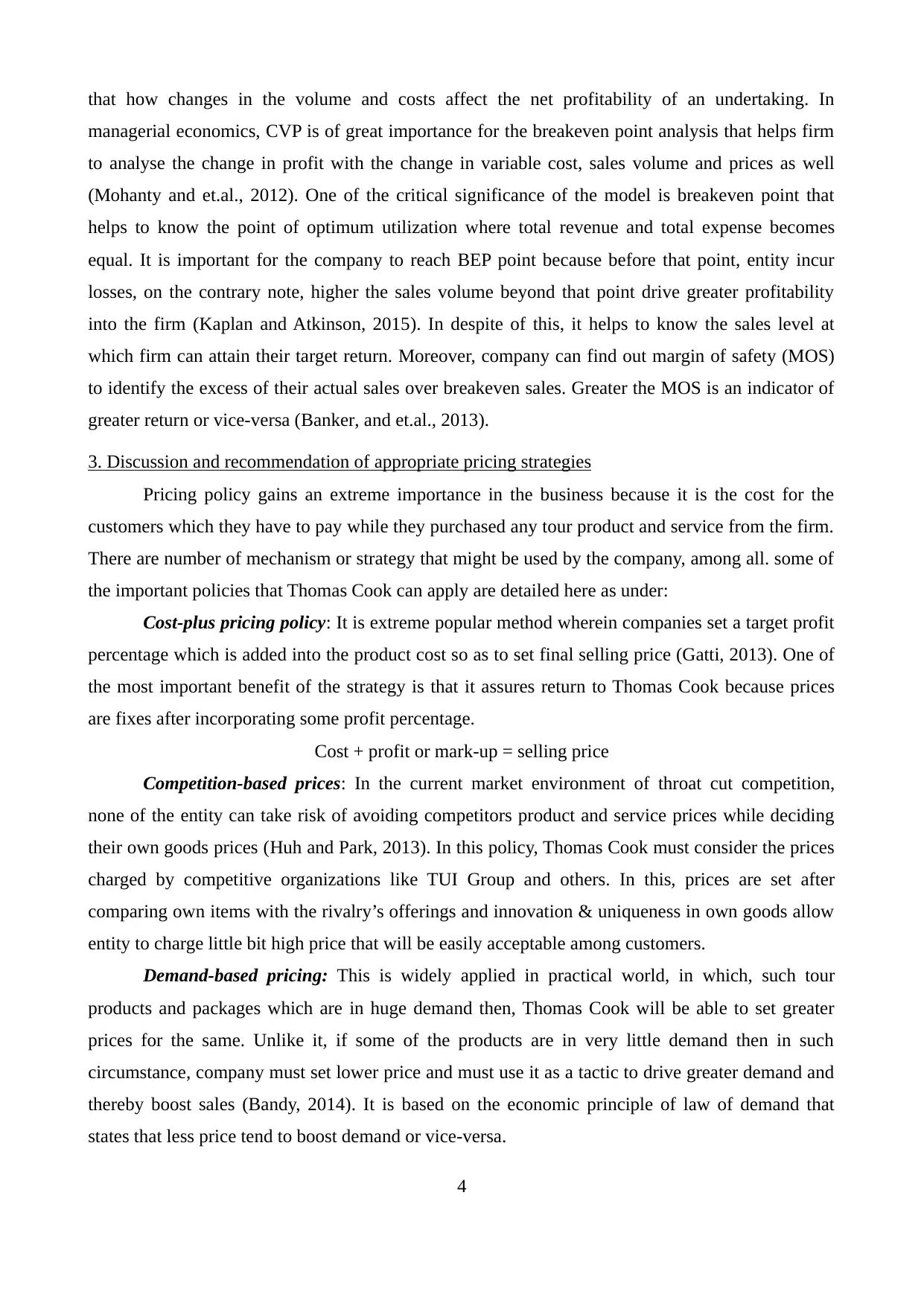
that how changes in the volume and costs affect the net profitability of an undertaking. In
managerial economics, CVP is of great importance for the breakeven point analysis that helps firm
to analyse the change in profit with the change in variable cost, sales volume and prices as well
(Mohanty and et.al., 2012). One of the critical significance of the model is breakeven point that
helps to know the point of optimum utilization where total revenue and total expense becomes
equal. It is important for the company to reach BEP point because before that point, entity incur
losses, on the contrary note, higher the sales volume beyond that point drive greater profitability
into the firm (Kaplan and Atkinson, 2015). In despite of this, it helps to know the sales level at
which firm can attain their target return. Moreover, company can find out margin of safety (MOS)
to identify the excess of their actual sales over breakeven sales. Greater the MOS is an indicator of
greater return or vice-versa (Banker, and et.al., 2013).
3. Discussion and recommendation of appropriate pricing strategies
Pricing policy gains an extreme importance in the business because it is the cost for the
customers which they have to pay while they purchased any tour product and service from the firm.
There are number of mechanism or strategy that might be used by the company, among all. some of
the important policies that Thomas Cook can apply are detailed here as under:
Cost-plus pricing policy: It is extreme popular method wherein companies set a target profit
percentage which is added into the product cost so as to set final selling price (Gatti, 2013). One of
the most important benefit of the strategy is that it assures return to Thomas Cook because prices
are fixes after incorporating some profit percentage.
Cost + profit or mark-up = selling price
Competition-based prices: In the current market environment of throat cut competition,
none of the entity can take risk of avoiding competitors product and service prices while deciding
their own goods prices (Huh and Park, 2013). In this policy, Thomas Cook must consider the prices
charged by competitive organizations like TUI Group and others. In this, prices are set after
comparing own items with the rivalry’s offerings and innovation & uniqueness in own goods allow
entity to charge little bit high price that will be easily acceptable among customers.
Demand-based pricing: This is widely applied in practical world, in which, such tour
products and packages which are in huge demand then, Thomas Cook will be able to set greater
prices for the same. Unlike it, if some of the products are in very little demand then in such
circumstance, company must set lower price and must use it as a tactic to drive greater demand and
thereby boost sales (Bandy, 2014). It is based on the economic principle of law of demand that
states that less price tend to boost demand or vice-versa.
4
managerial economics, CVP is of great importance for the breakeven point analysis that helps firm
to analyse the change in profit with the change in variable cost, sales volume and prices as well
(Mohanty and et.al., 2012). One of the critical significance of the model is breakeven point that
helps to know the point of optimum utilization where total revenue and total expense becomes
equal. It is important for the company to reach BEP point because before that point, entity incur
losses, on the contrary note, higher the sales volume beyond that point drive greater profitability
into the firm (Kaplan and Atkinson, 2015). In despite of this, it helps to know the sales level at
which firm can attain their target return. Moreover, company can find out margin of safety (MOS)
to identify the excess of their actual sales over breakeven sales. Greater the MOS is an indicator of
greater return or vice-versa (Banker, and et.al., 2013).
3. Discussion and recommendation of appropriate pricing strategies
Pricing policy gains an extreme importance in the business because it is the cost for the
customers which they have to pay while they purchased any tour product and service from the firm.
There are number of mechanism or strategy that might be used by the company, among all. some of
the important policies that Thomas Cook can apply are detailed here as under:
Cost-plus pricing policy: It is extreme popular method wherein companies set a target profit
percentage which is added into the product cost so as to set final selling price (Gatti, 2013). One of
the most important benefit of the strategy is that it assures return to Thomas Cook because prices
are fixes after incorporating some profit percentage.
Cost + profit or mark-up = selling price
Competition-based prices: In the current market environment of throat cut competition,
none of the entity can take risk of avoiding competitors product and service prices while deciding
their own goods prices (Huh and Park, 2013). In this policy, Thomas Cook must consider the prices
charged by competitive organizations like TUI Group and others. In this, prices are set after
comparing own items with the rivalry’s offerings and innovation & uniqueness in own goods allow
entity to charge little bit high price that will be easily acceptable among customers.
Demand-based pricing: This is widely applied in practical world, in which, such tour
products and packages which are in huge demand then, Thomas Cook will be able to set greater
prices for the same. Unlike it, if some of the products are in very little demand then in such
circumstance, company must set lower price and must use it as a tactic to drive greater demand and
thereby boost sales (Bandy, 2014). It is based on the economic principle of law of demand that
states that less price tend to boost demand or vice-versa.
4
⊘ This is a preview!⊘
Do you want full access?
Subscribe today to unlock all pages.

Trusted by 1+ million students worldwide
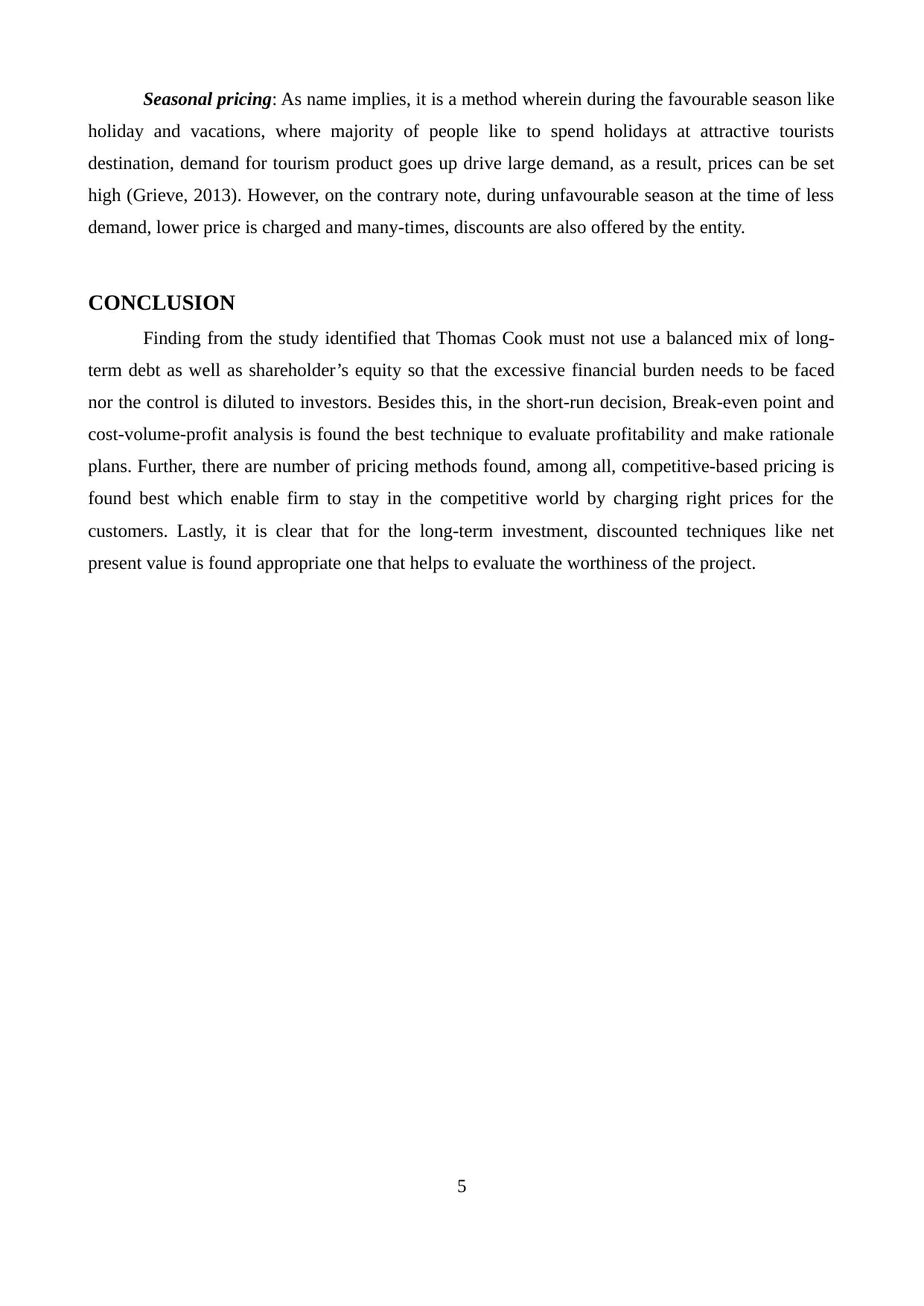
Seasonal pricing: As name implies, it is a method wherein during the favourable season like
holiday and vacations, where majority of people like to spend holidays at attractive tourists
destination, demand for tourism product goes up drive large demand, as a result, prices can be set
high (Grieve, 2013). However, on the contrary note, during unfavourable season at the time of less
demand, lower price is charged and many-times, discounts are also offered by the entity.
CONCLUSION
Finding from the study identified that Thomas Cook must not use a balanced mix of long-
term debt as well as shareholder’s equity so that the excessive financial burden needs to be faced
nor the control is diluted to investors. Besides this, in the short-run decision, Break-even point and
cost-volume-profit analysis is found the best technique to evaluate profitability and make rationale
plans. Further, there are number of pricing methods found, among all, competitive-based pricing is
found best which enable firm to stay in the competitive world by charging right prices for the
customers. Lastly, it is clear that for the long-term investment, discounted techniques like net
present value is found appropriate one that helps to evaluate the worthiness of the project.
5
holiday and vacations, where majority of people like to spend holidays at attractive tourists
destination, demand for tourism product goes up drive large demand, as a result, prices can be set
high (Grieve, 2013). However, on the contrary note, during unfavourable season at the time of less
demand, lower price is charged and many-times, discounts are also offered by the entity.
CONCLUSION
Finding from the study identified that Thomas Cook must not use a balanced mix of long-
term debt as well as shareholder’s equity so that the excessive financial burden needs to be faced
nor the control is diluted to investors. Besides this, in the short-run decision, Break-even point and
cost-volume-profit analysis is found the best technique to evaluate profitability and make rationale
plans. Further, there are number of pricing methods found, among all, competitive-based pricing is
found best which enable firm to stay in the competitive world by charging right prices for the
customers. Lastly, it is clear that for the long-term investment, discounted techniques like net
present value is found appropriate one that helps to evaluate the worthiness of the project.
5
Paraphrase This Document
Need a fresh take? Get an instant paraphrase of this document with our AI Paraphraser
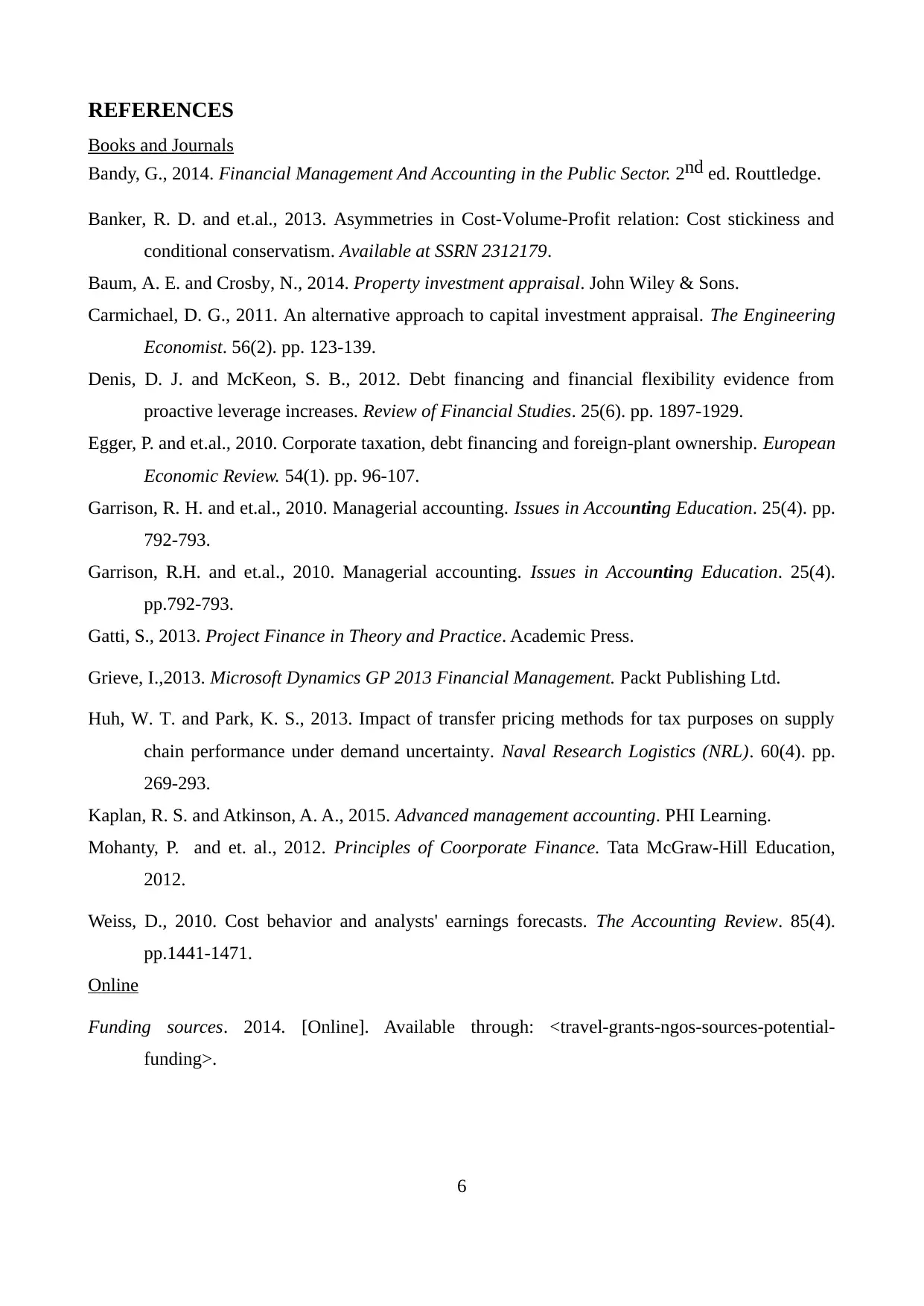
REFERENCES
Books and Journals
Bandy, G., 2014. Financial Management And Accounting in the Public Sector. 2nd ed. Routtledge.
Banker, R. D. and et.al., 2013. Asymmetries in Cost-Volume-Profit relation: Cost stickiness and
conditional conservatism. Available at SSRN 2312179.
Baum, A. E. and Crosby, N., 2014. Property investment appraisal. John Wiley & Sons.
Carmichael, D. G., 2011. An alternative approach to capital investment appraisal. The Engineering
Economist. 56(2). pp. 123-139.
Denis, D. J. and McKeon, S. B., 2012. Debt financing and financial flexibility evidence from
proactive leverage increases. Review of Financial Studies. 25(6). pp. 1897-1929.
Egger, P. and et.al., 2010. Corporate taxation, debt financing and foreign-plant ownership. European
Economic Review. 54(1). pp. 96-107.
Garrison, R. H. and et.al., 2010. Managerial accounting. Issues in Accounting Education. 25(4). pp.
792-793.
Garrison, R.H. and et.al., 2010. Managerial accounting. Issues in Accounting Education. 25(4).
pp.792-793.
Gatti, S., 2013. Project Finance in Theory and Practice. Academic Press.
Grieve, I.,2013. Microsoft Dynamics GP 2013 Financial Management. Packt Publishing Ltd.
Huh, W. T. and Park, K. S., 2013. Impact of transfer pricing methods for tax purposes on supply
chain performance under demand uncertainty. Naval Research Logistics (NRL). 60(4). pp.
269-293.
Kaplan, R. S. and Atkinson, A. A., 2015. Advanced management accounting. PHI Learning.
Mohanty, P. and et. al., 2012. Principles of Coorporate Finance. Tata McGraw-Hill Education,
2012.
Weiss, D., 2010. Cost behavior and analysts' earnings forecasts. The Accounting Review. 85(4).
pp.1441-1471.
Online
Funding sources. 2014. [Online]. Available through: <travel-grants-ngos-sources-potential-
funding>.
6
Books and Journals
Bandy, G., 2014. Financial Management And Accounting in the Public Sector. 2nd ed. Routtledge.
Banker, R. D. and et.al., 2013. Asymmetries in Cost-Volume-Profit relation: Cost stickiness and
conditional conservatism. Available at SSRN 2312179.
Baum, A. E. and Crosby, N., 2014. Property investment appraisal. John Wiley & Sons.
Carmichael, D. G., 2011. An alternative approach to capital investment appraisal. The Engineering
Economist. 56(2). pp. 123-139.
Denis, D. J. and McKeon, S. B., 2012. Debt financing and financial flexibility evidence from
proactive leverage increases. Review of Financial Studies. 25(6). pp. 1897-1929.
Egger, P. and et.al., 2010. Corporate taxation, debt financing and foreign-plant ownership. European
Economic Review. 54(1). pp. 96-107.
Garrison, R. H. and et.al., 2010. Managerial accounting. Issues in Accounting Education. 25(4). pp.
792-793.
Garrison, R.H. and et.al., 2010. Managerial accounting. Issues in Accounting Education. 25(4).
pp.792-793.
Gatti, S., 2013. Project Finance in Theory and Practice. Academic Press.
Grieve, I.,2013. Microsoft Dynamics GP 2013 Financial Management. Packt Publishing Ltd.
Huh, W. T. and Park, K. S., 2013. Impact of transfer pricing methods for tax purposes on supply
chain performance under demand uncertainty. Naval Research Logistics (NRL). 60(4). pp.
269-293.
Kaplan, R. S. and Atkinson, A. A., 2015. Advanced management accounting. PHI Learning.
Mohanty, P. and et. al., 2012. Principles of Coorporate Finance. Tata McGraw-Hill Education,
2012.
Weiss, D., 2010. Cost behavior and analysts' earnings forecasts. The Accounting Review. 85(4).
pp.1441-1471.
Online
Funding sources. 2014. [Online]. Available through: <travel-grants-ngos-sources-potential-
funding>.
6

7
⊘ This is a preview!⊘
Do you want full access?
Subscribe today to unlock all pages.

Trusted by 1+ million students worldwide
1 out of 9
Related Documents
Your All-in-One AI-Powered Toolkit for Academic Success.
+13062052269
info@desklib.com
Available 24*7 on WhatsApp / Email
![[object Object]](/_next/static/media/star-bottom.7253800d.svg)
Unlock your academic potential
Copyright © 2020–2025 A2Z Services. All Rights Reserved. Developed and managed by ZUCOL.





